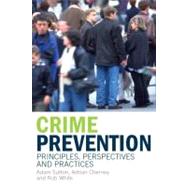
| Preface and acknowledgments | p. ix |
| Theory | |
| Introduction: Crime prevention and community safety in Australia | p. 3 |
| Key approaches and frameworks | p. 12 |
| Introduction | p. 12 |
| Prevention of crime as disputed terrain | p. 14 |
| Crime and everyday life | p. 17 |
| Classifications of crime prevention | p. 21 |
| Crime prevention versus community safety | p. 25 |
| Crime prevention and problem solving | p. 26 |
| Conclusion | p. 29 |
| Social prevention | p. 32 |
| Introduction | p. 32 |
| Cambridge-Somerville: The perils of social prevention | p. 34 |
| Structure and agency | p. 35 |
| Approaches to social prevention | p. 36 |
| From theory to policy | p. 39 |
| Limits to social prevention | p. 41 |
| The future | p. 43 |
| Conclusion | p. 46 |
| Environmental prevention | p. 48 |
| Introduction | p. 48 |
| SCP and CPTED | p. 50 |
| SCP: Principles and approaches | p. 51 |
| The importance of opportunity | p. 51 |
| Key situational techniques | p. 52 |
| Critiques of SCP | p. 54 |
| Situational analysis: Being creative | p. 58 |
| CPTED: Impact and use of the physical environment | p. 60 |
| CPTED pioneers | p. 61 |
| Core CPTED techniques | p. 62 |
| Influence on policy and practice | p. 64 |
| Applying CPTED | p. 67 |
| Conclusion | p. 68 |
| Evaluating crime prevention | p. 70 |
| Introduction | p. 70 |
| Different methods of evaluation | p. 71 |
| Outcome evaluation | p. 72 |
| Experimental method | p. 73 |
| Quasi-experimental designs | p. 74 |
| Non-experimental method | p. 75 |
| Systematic reviews | p. 76 |
| Cost-benefit analysis | p. 78 |
| Process evaluation | p. 80 |
| Developing an evidence base | p. 82 |
| Building local capacity | p. 86 |
| Measuring the political | p. 88 |
| Conclusion | p. 90 |
| Practice | |
| From research to policy | p. 93 |
| Introduction | p. 93 |
| France: Politics | p. 95 |
| The Netherlands: A genuine alternative? | p. 98 |
| The United Kingdom: Ambition | p. 101 |
| Australia: Working together? | p. 105 |
| The way forward | p. 107 |
| Conclusion | p. 112 |
| Prevention in public places | p. 114 |
| Introduction | p. 114 |
| Community participation and social inclusion | p. 115 |
| Involving youth in crime prevention | p. 118 |
| Lessons from the streets | p. 121 |
| Planning and design issues | p. 122 |
| Shopping centres and public malls | p. 123 |
| Planning processes | p. 123 |
| Management protocols | p. 123 |
| Participation and service provision | p. 124 |
| Crime prevention and community spaces | p. 125 |
| The public mall | p. 126 |
| Youth-friendly shopping centres | p. 128 |
| Conclusion | p. 133 |
| Dealing with social disorder | p. 135 |
| Introduction | p. 135 |
| Multipronged approaches | p. 136 |
| Ambiguities of public space | p. 138 |
| Graffiti and social disorder | p. 140 |
| Graffiti removal campaigns | p. 143 |
| Target hardening | p. 143 |
| Discouraging and/or displacing graffiti | p. 143 |
| Community involvement | p. 144 |
| Graffitists' involvement | p. 144 |
| Youth gangs and social conflict | p. 147 |
| Unexpected disruptions to the community | p. 151 |
| Conclusion | p. 154 |
| Planning the future | p. 155 |
| Introduction | p. 155 |
| Metropolis City | p. 158 |
| Learning from the past | p. 160 |
| Planning for the future | p. 162 |
| Conclusion | p. 162 |
| References | p. 164 |
| Index | p. 185 |
| Table of Contents provided by Ingram. All Rights Reserved. |
The New copy of this book will include any supplemental materials advertised. Please check the title of the book to determine if it should include any access cards, study guides, lab manuals, CDs, etc.
The Used, Rental and eBook copies of this book are not guaranteed to include any supplemental materials. Typically, only the book itself is included. This is true even if the title states it includes any access cards, study guides, lab manuals, CDs, etc.